You’ll gain in-depth insight and conclude gaining muscle with bodyweight training is possible, providing you follow muscle building principles, which hold true for weights, machines, and bodyweight workouts alike. As always, I want to provide maximum value in exchange for your visit and subsequent exploring of ‘Gaining muscle with bodyweight training: calisthenics vs weights‘. Answering the blog title requires an in-depth article, ensuring a comprehensive overview is effectively delivered to you.
FAQs Gaining Muscle with Bodyweight Training: Calisthenics vs Weights
1. Can I really build muscle with bodyweight training alone?
Yes, you can! Bodyweight training, when paired with progressive overload and proper nutrition, can build muscle effectively. The key is challenging your muscles through harder variations of exercises, like progressing from push-ups to one-arm push-ups or adding weight to pull-ups.
2. Which is better for muscle growth: calisthenics or weights?
Neither is inherently superior. Both calisthenics and weight training can stimulate muscle growth if you follow muscle-building principles like progressive overload and sufficient recovery. Your choice depends on your goals, preferences, and access to equipment.
3. What are the advantages of calisthenics over weight training?
Calisthenics offers versatility, low cost, and reduced joint stress, making it an excellent option for beginners or those without access to a gym. It also builds functional strength and improves mobility since many exercises engage multiple muscle groups simultaneously.
4. How do I progress in bodyweight training to continue building muscle?
Progression in bodyweight training involves modifying exercises to increase difficulty. For example:
- Push-ups → One-arm push-ups
- Pull-ups → Weighted pull-ups
- Squats → Pistol squats
You can also add reps, sets, or external resistance like weighted vests.
5. What are the limitations of bodyweight training?
Bodyweight training can lack isolation exercises for specific muscles, making it harder to target weaker areas. Additionally, progression may plateau, especially for advanced trainees, as exercises like one-arm push-ups or pistol squats can be challenging to master.
6. Can bodyweight training help me get lean and ripped?
Yes, but the “lean and ripped” look comes primarily from diet and achieving a low body fat percentage. While calisthenics can help build muscle and endurance, fat loss is achieved through a calorie deficit.
7. Can I combine calisthenics with weight training for better results?
Absolutely! Combining both approaches creates a hybrid training program that maximises strength, muscle growth, and functional fitness. For example, use weights for isolation and compound lifts, and incorporate calisthenics for mobility and core strength.
What Is Bodyweight Training?
Let’s start with the glaringly obvious:
Bodyweight training (also known as calisthenics) utilises your own body to provide a muscle building stimulus and adaptation response.
Calisthenics vs Weights: 4 Key Differences
1) Equipment Requirement
- Bodyweight training requires little to no equipment and is more versatile to perform anywhere.
- Weight training is performed with external weights such as dumbbells, barbells, or machines and is typically found in gyms. A good home weight training setup can be substantial.
2) Progressive Overload
Bodyweight training progression involves modifying exercises to harder variations or changing leverage (e.g., normal to one-handed push-ups).
Weight training is generally more straightforward by increasing the amount of weight lifted with good form.
3) Joint Stress
Bodyweight training generally places less strain on joints and is often accepted as safer for long-term joint health.
Weight training can place significant stress on joints, especially with improper form or excessive weights, increasing the risk of injury. Especially if not completed in a slow and controlled manner.
4) Muscle Isolation vs Compound Movements
Weight training, in addition to multi-joint compound exercises, utilises isolation training, enabling targeted muscle growth and strength development. This can be further compounded with supersets and rest-pause training. This is hard to replicate with calisthenics.
Bodyweight training focuses on compound movements that engage multiple muscle groups simultaneously.
A History of Calisthenics
Let’s start with a shocking fact. Your local Gold’s Gym, Fitness First, or whatever your gym is called, didn’t exist during ancient times. Our modern era has relegated strength and fitness to recreation for the majority and a profession for the minority.
Ancient Calisthenics
Physical strength was crucial to our ancient ancestors. Being stronger, faster, and fitter was crucial to surviving an enemy onslaught on the battlefield.
In order to get stronger, our Spartan warrior couldn’t stroll into his local gym for a Monday chest and arms session, followed by a sauna and a creatine-spiked protein shake. Nope, our fierce friend was required to utilise another method to get strong…
Calisthenics is derived from the Greek word ‘Kalos’, meaning beauty, and ‘sthenos’, meaning strength. Greek warriors performed basic push-ups and sit-ups to increase strength for battle. Gaining muscle with bodyweight training was a literal life-or-death endeavour.
Moving to Asia, Chinese martial artists incorporated bodyweight workouts to build muscle, flexibility, and strength. To this day, Shaolin Monks display impressive bodyweight and general resilience feats.
The Roman army heavily emphasised physical training within its ranks. Strict training regimes of bodyweight workouts, running, and jumping were performed daily. The Romans were aware that peak physical condition was essential for military campaign success.
India developed various bodyweight workouts that survived in popularity to this day. Perhaps you’ve heard of yoga? Yes, the plank and downward-facing dog have existed for thousands of years.

The Renaissance and Beyond
The focus on bodyweight training continued as the world meandered into the Renaissance, particularly for the militaries of the world.
During this period, various anatomy studies, including those by Leonardo da Vinci, highlighted the importance of strength and physical fitness.
In the 18th and 19th centuries, bodyweight gymnastics grew in popularity and became incorporated into physical education programs. Friedrich Ludwig Jahn (the father of modern gymnastics) founded the German Turnverein Movement. This movement emphasised the importance of physical fitness and included a variety of bodyweight exercises, such as pull-ups, push-ups, and bodyweight squats as part of its training regime.

Modern Bodyweight Training
To this day, bodyweight workouts are a staple of military units worldwide. They’re used as selection test criteria and throughout a soldier’s career.
Bodyweight training is also heavily utilised by the world’s elite special forces units. Why? Because they work and can be performed in most situations with very little equipment.
The latter part of the 20th century and early 21st century witnessed the resurgence of calisthenics workouts.
CrossFit heavily utilises bodyweight workouts, and mainstream gyms have been capitalising on their popularity. Gaining muscle with bodyweight training is very much in!
Basic Muscle Building Principles
It’s essential you simplify muscle building to understand how bodyweight workouts build muscle. The below blog sections will deliver more clarity once the basics have been refreshed.
Muscle Building Growth Simplified
A fantastic method of causing mass confusion is to complicate a relatively basic subject (take getting abs as an example, good article on this here) and blow people away with large sentences filled to the brim with complex-sounding words. This can add false credibility to a whole bunch of rubbish and make the calisthenics vs weights subject more convoluted than reality.
I mostly attempt to adhere to the following rule: “If you can’t explain it for a two-year-old brain, you don’t understand the subject well enough.” So, here’s a basic muscle-building growth explanation:
- Muscle fibres sustain damage through intense enough exercise to elicit an adaptation response.
- Subject to adequate nutrition and rest, the muscle regrows bigger and stronger.
- For the muscle to repeat the process, it must be subjected to a larger stimulus (progressive overload) in order to adapt and grow.
- And so the cycle continues if muscle building is the perpetual goal.
Keeping this section as a homage to simplification, I’m drawing this part to a premature close. This is muscle growth in a nutshell. The physiological process of muscle building remains constant, regardless of whether calisthenics or weights have triggered muscle fibre damage.
Remember, the body understands overload and tension! Whether it’s delivered from bodyweight training, free weights, or lifting bricks, it’s irrelevant! Always simplify questionable logic, and you’ll become deception-proof within this sometimes shark-infested fitness game.
Calisthenics can improve muscular endurance and strength across various muscle groups, particularly when combined with progressive overload techniques such as adding weight or increasing difficulty
The Truth Shall Set Us Free: Calisthenics vs Weights
Armed with the above basic muscle building principles, we can stipulate whether calisthenics vs free weights is better for muscle building. Here’s the answer:
Both calisthenics and weights are equally as good or bad for muscle building. Whatever method of strength training you utilise, if you train hard enough to damage the muscle fibres and correctly fuel up and rest, congratulations—you’ve triggered muscle growth! If you didn’t, try again next time!
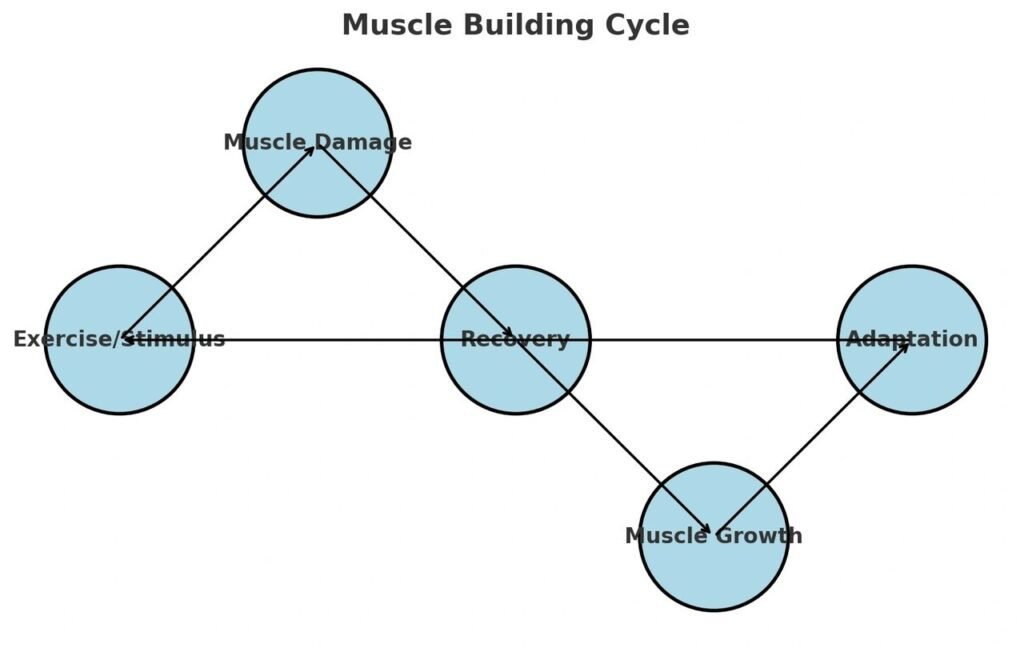
Calisthenics vs Weights – What the Science Says
When comparing calisthenics to weight training, scientific research shows that both methods can be equally effective for building muscle, provided that progressive overload is applied. According to a study published in the Journal of Strength and Conditioning Research, muscle growth occurs when the muscle is subjected to tension, regardless of whether that tension comes from bodyweight exercises or free weights.
A key factor in muscle hypertrophy is the total volume of work—repetitions, sets, and intensity—rather than the type of resistance used. For example, one study conducted at the University of Tampa found that participants engaging in high-volume bodyweight exercises, such as push-ups and pull-ups, showed similar strength and muscle mass gains as those lifting weights over a 12-week period.
Additionally, a meta-analysis from Sports Medicine highlighted that while weight training allows for more precise control of resistance (by simply adding more weight), calisthenics offers the advantage of improving functional fitness, mobility, and joint stability, making it a more holistic approach for many individuals. If you’ve ever seen an injury from going too heavy weightlifting, it certainly makes you ask why you shouldn’t bench press.
Another interesting finding from research conducted by the American Council on Exercise is that bodyweight exercises can offer a lower risk of injury compared to free weights, especially for beginners or those recovering from injuries. However, both forms of training, when performed with proper form, are highly effective in improving overall strength and muscle development.
In summary, science supports the fact that both calisthenics and weight training can produce significant muscle gains. The deciding factor is not which is superior but which suits an individual’s fitness goals and personal preferences.
A study comparing bodyweight exercises with barbell squats found that both methods significantly increased muscle size and strength, but barbell squats produced more pronounced hypertrophy, especially in the lower body, due to the ability to add more load gradually.
Bodyweight Training Myth Busting
As I’ve stipulated above, gaining muscle with bodyweight training is certainly possible.
Beware of the bodyweight training zealot. For this person, gaining muscle with bodyweight training is the only path to enlightenment. You’ll be convinced of calisthenics’ ability to solve world hunger, cure all diseases, and get you ripped to the bone by the simple act of glancing in a pull-up bar’s direction.
As above, we’ve broken muscle building down to its most simplistic explanation. We will utilise the weapon of simplicity to dismantle some common bodyweight training myths.
The below statements are frequently repeated by bodyweight fanatics:
Bodyweight Training Is Superior to Free Weights
Nope, simplicity prevails. Providing nutrition and rest are in check, it’s irrelevant what the stimulus for muscle damage was, only that it’s been achieved through hard training.
Bodyweight Training Strips More Fat Off the Body, Due to Forcing the Body to Get Lighter
I’ve frequently heard this one in person and online. Again, see above. The same muscle building response can be achieved by bodyweight training or weights.
An energy deficit is the only true method to successfully achieve fat loss.
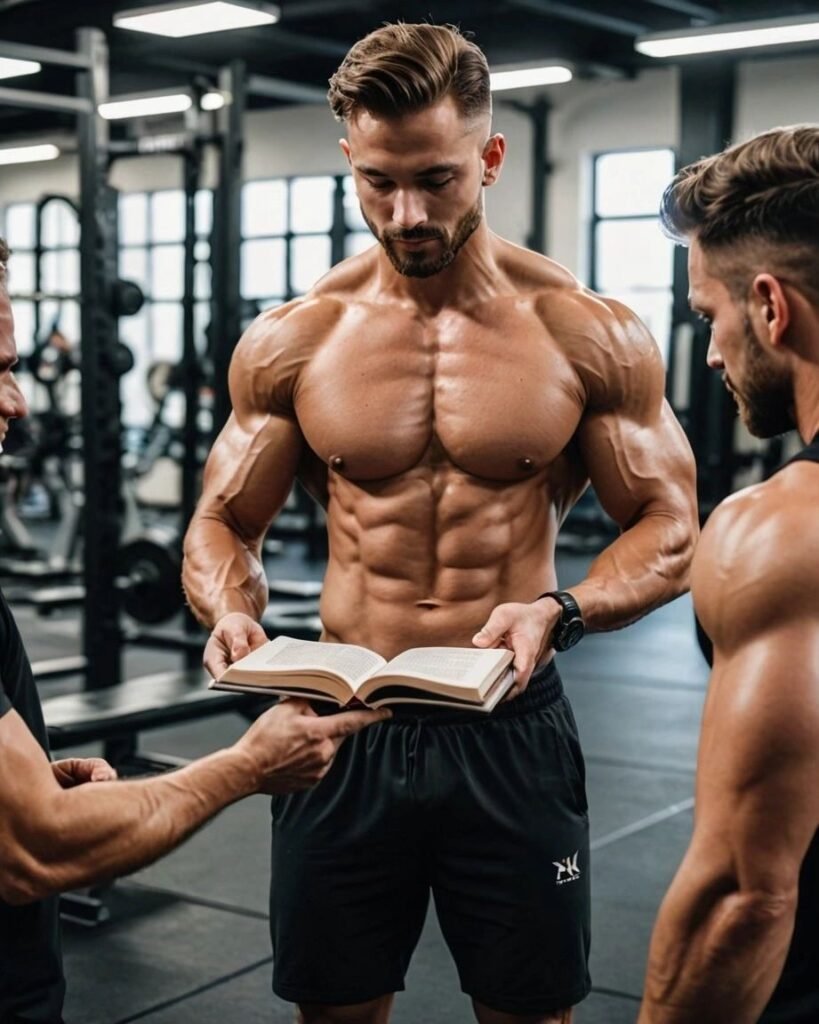
Bodyweight Workouts Get You Lean and Ripped Like a Gymnast. I Want to Look Like One.
This is false. An energy deficit gets you ripped and generally the way you look (within reason) is often dictated by genetics. I discuss this more in the article covering.
Calisthenics Exercises Target Multiple Muscle Groups Simultaneously, Resulting in a More Toned and Defined Physique
Fancy a stab at guessing where I extrapolated this gem from?
I took this from a Men’s Health article published this year. I’d be of a forgiving nature if the article was written in the 1960s. You must question the complete lack of scientific awareness by a major publication focused on men’s health. Let’s tear this one apart for the hell of it:
Free weight compound exercises also target multiple muscle groups simultaneously. It’s nevertheless a moot point, and I can further trump it. If you stimulate the targeted muscle with an isolation exercise, it will grow (providing rest and nutrition are on point).
Muscles don’t get more ‘toned and defined’ looking as a result of any strength training exercise. They get larger and stronger in response to strength training. That’s all, folks!
A loss of body fat achieves the defined and toned look. Is it any wonder why people are so confused?
Please don’t ascertain this section as bodyweight training bashing. Its fundamental purpose is to ensure you don’t get deceived into believing it’s the only way to train. Gaining muscle with bodyweight training and free weights is possible.
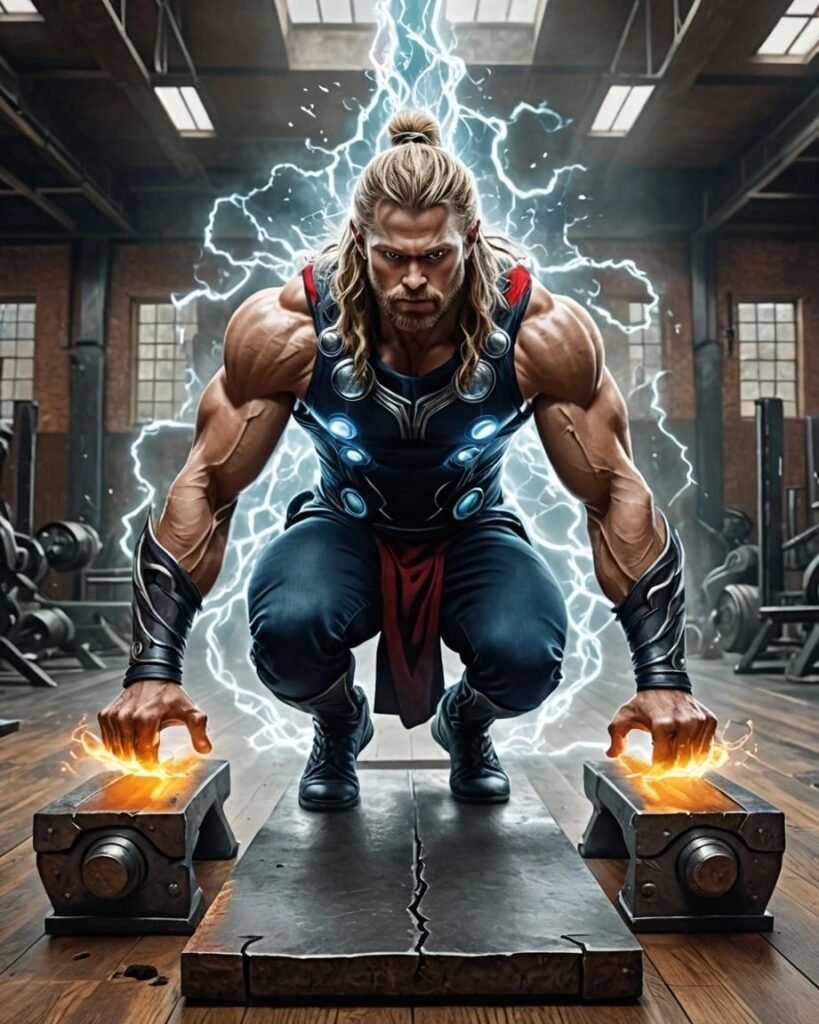
Bodyweight training exercises
For a multitude of possible reasons, you’ve chosen to solely muscle build with a bodyweight-only workout. Providing you successfully elicit a muscle building response as mentioned above, you’ll make sturdy progress.
We’ll cover the basic (but effective) bodyweight exercises below. To assist you in researching bespoke bodyweight training routines, I’d recommend the below-linked YouTube uploads. They are thorough and cover bodyweight progression workouts from beginners onwards. I’ve also got you covered with a great intermediate link too.
Calisthenics for beginners/In depth step-by-step guide too building muscle and strength
20 Best intermediate calisthenics exercises and workout plan
The amount of calisthenics exercises literally goes into the hundreds and potentially thousands.
All bodyweight training exercises can be categorised into 4 key categories.
Push
- Push-ups – chest, shoulders, triceps
- Handstand push-ups against a wall – shoulders, triceps
- Parallel bar dips – chest, shoulders, triceps
Pull
- Pull-ups (palms facing away) – back, biceps
- Chin-ups (palms facing) – back, biceps
Core
- Hanging knee raises – abs
- Sit-ups – abs
- Stomach crunches – abs
Legs
- Bodyweight lunge – quadriceps, hamstrings
- Bodyweight squat – quadriceps
The basic exercises above provide a complete full-body workout and ensure the potential of gaining muscle with bodyweight training. Progression will be almost identical to weight lifting, and the same program setup rules apply (sets, reps, rest times, volume, intensity, frequency, speed, etc.), with one notable addition being the search for harder exercise variants.
Harder Variant Examples:
One-legged squat (known as a pistol squat)
One-arm push-up or push-up with added weight
Pull-ups and dips with weight attached
Hanging leg raises with weight attached to the ankles
2 Flaws of Bodyweight Training
There are two main (not insurmountable) flaws with a sole focus on gaining muscle with bodyweight training:
1) Bodyweight Training Can Become Extremely Lengthy
If you stick within the beginner/mainstream exercises and progress well, you’ll imminently be undertaking many high reps to get the muscle building job done. A workout could look like this:
- Push-ups: 3 sets of 50
- Hanging knee raises: 3 sets of 30
- Handstand shoulder press: 3 sets of 30
- Pull-ups: 3 sets of 12
- Bodyweight squats: 3 sets of 50
- Chin-ups: 3 sets of 15
- Dips: 3 sets of 20
With adequate rest in between sets, this could escalate into a perpetually longer workout (not an issue for some, but I like to keep my workouts to 50 minutes) every time you workout.
The solution is to add weight, but bodyweight purists will have your eyeballs out!
A secondary solution is to progress in exercise difficulty, but for someone who doesn’t want to specialise in learning all bodyweight workouts, this can be problematic and time-consuming.
The learning curve difficulty is exceptionally steep moving from press-ups to one-arm press-ups, squats to pistol squats, etc., thus a plateau. Weights allow for a more incremental and steady progression increase.
2) Lack of Muscle Isolation Ability
Muscles develop at different rates, and we all have eventual underdevelopment weaknesses (the joys of genetics). Weights allow more specificity and isolating certain muscles and provide more of a volume stimulus to develop a proportionate physique (if that’s what you’re after).
Legs are also particularly troublesome. I can go near infinity reps on bodyweight squats and lunges, but the natural progression exercise, pistol squats aggravate my knees.
The calisthenics vs weights dispute is the equivalent of a hairdresser asking if you’d like the same haircut with different scissors. Provided the end outcome is achieved, who cares outside of the hairdresser’s personal preference?
How I Merge Free Weights and Bodyweight Training for Muscle Building
Those who have read my ‘Muscle Building Mistakes That Delayed Me Getting Lean and Ripped’ article will already be aware that, in addition to my cardio aspirations, I weight train three days a week following a simple A-B-A template (usually Tuesday, Thursday, Sunday) and opt for hard work over too many exercises and junk volume.
I train martial arts in addition to participating in the odd endurance event. Successful handling of my own bodyweight is paramount.
A Typical Setup Is as Follows (I rarely deviate too much these days, and muscle confusion is a complete myth):
Workout A: Push and Abs (all 6–10 reps unless otherwise stipulated- the isolation exercises are often completed rest pause style)
- Incline dumbbell press – 3 sets of 50kg
- Flat dumbbell press – 3 sets of 46kg
- Pec deck or flys – 3 sets with 12–15 reps
- Barbell shoulder press – 3 sets with 70kg
- Dips with 60kg attached to my waist
- Tricep rope extension – 3 sets of 12–15
- Hanging leg raises – 3 sets of 20
- Ab wheel rollout – 3 sets of 20
- Press-ups – one set to absolute failure
Workout B: Pull and Legs (as above reps)
- Trap bar deadlift (low handles) – 3 sets 380kg
- Weighted pull-ups – 3 sets with 30kg around the waist
- Chin-ups (no weight) – 3 sets of 12–15
- Dumbbell row – 3 sets of 46kg
- Barbell curl – 3 sets of 12–15
- Leg press – 3 sets of 160kg 12–15 reps
- Hamstring curls – 3 sets of 60kg 12–15 reps
From the above 16 exercises, 6 are highlighted bodyweight exercises plus weight. Just shy of 38% of my strength training exercises are calisthenics.
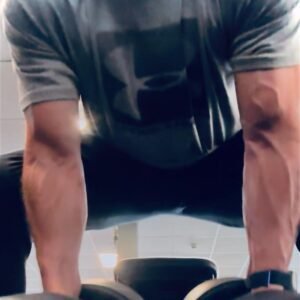
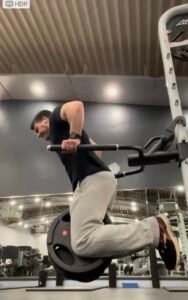
The additional weight I strap around me during the weighted pull-ups, allows me to complete 20 bodyweight only pull-ups. I can perform 70 press-ups following a tough push workout and can perform most advanced calisthenics workouts at age 42 and natural. Not too shabby. You’ll also find my workout nicely follows the science in line with the best frequency and sets/reps for building muscle.
Confession time, I possess the raw strength for a muscle up, but there’s something about the mechanism I can’t quite grasp. To my horror, my brother in law has been able to complete these for years…..
Conclusion and closing thoughts
Whether you solely undertake gaining muscle with bodyweight training or facilitate a more hybrid approach (similar to me), the calisthenics vs weights dispute should hold no serious thought in an avid strength training enthusiast’s mind.
The toolbox is named muscle building, and both methods of training are critical and viable tools within the box. They can be called upon when one or both are required.
One last point I’d like to leave you with is genetics. Regardless of your genetic hand dealt for muscle building, you can achieve an outstanding physique compared to where it is today.
That said, some individuals are more responsive to any strength training than others. The point being, switching from weights to calisthenics is unlikely to give you the silver bullet you’re searching for. Program hopping can ruin your best productive years of training. Been there and very much bought the T-shirt.
Whatever path you choose, work harder and be better than yesterday, and ensure you’re always tracking your progress. What gets measured gets done.
Chat soon,
Matt
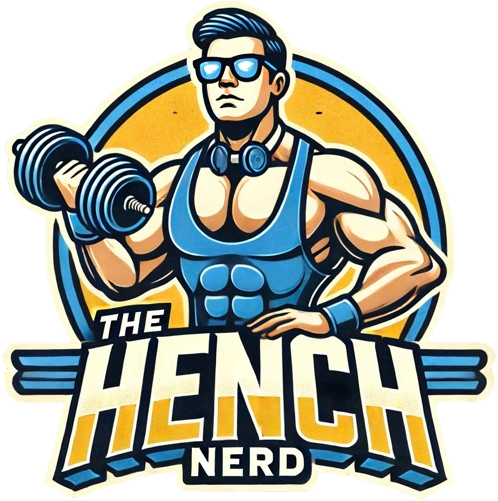

1 thought on “Gaining muscle with bodyweight training: calisthenics vs weights”
Comments are closed.